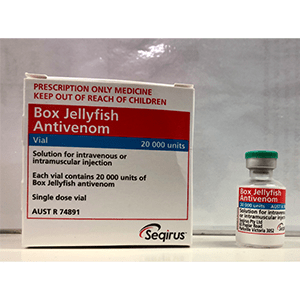Presentation
1.5 – 4mL vial
Keep Refrigerated
Contains
20 000 units Box Jellyfish Antivenom
Role
Management of life-threatening box jellyfish envenomation associated with cardiac and/or respiratory collapse.

Consultation with a clinical toxicologist is recommended through local toxicology service or Poisons Information Centre 13 11 26.
Dose
1 vial administered by slow IV injection following a 1:10 dilution with sodium chloride 0.9%. Dilution can be 1:5 in children or patients with fluid restriction.
Stocking recommendations for coastal hospitals north of Gladstone (inclusive)
| Tertiary centre | Regional centre | Rural centre | Remote centre |
|---|---|---|---|
| 2-4 vials | 1 vials | 0-1 vials | 0 vials |
Rationale
Survival following box jellyfish envenomation relies on the early provision of ACLS. Good resuscitation should be the mainstay of treatment. The efficacy of box jellyfish antivenom has not been proven, nor is the optimal dosing regimen known. The current stocking recommendations reflect a pragmatic approach to antivenom stocking.
Precautions
- Hypersensitivity reactions may occur. Antivenom should be administered in a critical care area in anticipation of potential anaphylaxis.
- Premedication with steroids/adrenaline is not recommended.
- If a hypersensitivity reaction occurs, pause the infusion and treat along standard lines. Recommence the infusion once the reaction settles at a slower rate.
- If the hypersensitivity reaction is severe, discuss the case with a clinical toxicologist.
Serum sickness may occur 4 to 14 days following the administration of antivenom. Symptoms include fever, rash, joint and muscle pain, headache, nausea and vomiting. Patients should be informed of the symptoms and present to their local doctor should they occur.
Disclaimer
Fact sheet developed by Queensland Poisons Information Centre.
This fact sheet is about the use of these antidotes in Australia, and may not apply to other countries. Children’s Health Queensland Hospital and Health Service cannot be held responsible for the accuracy of information, omissions of information, or any actions that may be taken as a consequence of reading this fact sheet.